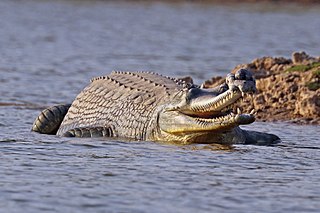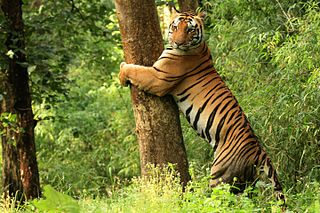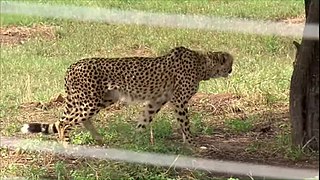This article needs additional citations for verification .(March 2024) |
Bhopal is the capital of Madhya Pradesh state of India.
This article needs additional citations for verification .(March 2024) |
Bhopal is the capital of Madhya Pradesh state of India.
The Van Vihar National Park is a national park located in the heart of Bhopal. Although declared a national park in 1983, it is developed and managed as a modern zoological park. It covers an area of about 4.45 km².
CREW is a society registered in 1997 under the Madhya Pradesh Society Registration Act 1973. CREW's aim is to emerge as Central India's primary centre for policy and enforcement regarding conservation and management of natural resources, wildlife and biodiversity. The Central Indian States of Madhya Pradesh and Chhattisgarh have distinctive characteristics that set this region apart from other areas of the Indian sub-continent. Besides the wealth of natural resources-both forest and mineral--some of the most important archaeological sites, dating back to ten thousand years are located in Madhya Pradesh.
CREW has continued to campaign for the protection of environment, biodiversity, wildlife, forest cover, endangered species and wetlands. CREW uses the visual media and releases b-rolls in digital broadcast quality format on crucial environment related issues to different sections of the media for direct relay and wider dissemination of knowledge and information relating to natural environment and factors threatening environmental balance. As a major initiative to build awareness regarding the importance of wetlands and their conservation, Crew launched an awareness campaign with its documentary "water Birds of Bhopal" shot mainly around Van Vihar National Park, a huge wetland recognized by the Ramsar Convention as an important wetland site in Central India.
Crew has produced the documentary "Endangered Gharial (crocodilian gharial crisis)" to tell how India's special crocodilian Gharial, considered to be one of the most critically endangered of all crocodilian species, is threatened by the destruction of its nesting and basking sites and shrinking prey base. Gharials get caught in fishing nets and are killed by fishermen and turtle hunters.
In collaboration with the Regional Natural History Museum Crew organised a forest, wildlife and birding training camp for college and university teaching staff in the Satpura Tiger Reserve. Crew also organises birding camps for village children.
A number of risks and practices are threatening forests, wildlife, wetlands and the environment. Crew works hard at preventing them. These threats include:
Crew had released two reports Vanishing Stripes (1999) [1] and Vanishing Stripes-II (2000) [2] to issue the firm warning that tiger's survival is threatened by poaching and loss of prey-base. Our forests are shrinking at an alarming pace. Human pressure on forest is immense due to rapidly increasing population. The situation gets aggravated by reckless destruction of green cover by the timber and the mining mafia. Forest land is also getting rapidly encroached. Unhindered grazing, minor forest produce and firewood collection are also activities adding to the crisis.
From 710 tigers in the last tiger estimation before 2006, the tiger population in the central Indian State of Madhya Pradesh came down to 276 in the 2006 tiger population estimation. On an all-India basis, In 2006, the tiger population was estimated at 1,411 (1,165 to 1,657) which was much lower than the earlier official estimates. The latest tiger figures were presented by the Wildlife Institute of India and the Tiger Conservation Authority of the Government of India at a seminar held at the India Habitat Centre, New Delhi on 23 May 2007. The seminar was attended by Prodipto Ghosh, Secretary of Union Ministry of Environment and Forest, chief wildlife wardens, and tiger reserve directors from many states.
The latest tiger population estimate glaringly shows that most of those at the helm of affairs have never bothered to realize the gravity of the problem on the tiger front. They have only offered lip-service and exhibited superficial concern for the basic issues involved. They have remained mainly interested in deriving benefits, both financial and political by allowing populist activities to continue even in the core forest areas. Unless ecological balance is ensured on a long-term basis, no living species, including human beings, may be able to survive.
Forests in India have been shrinking at an alarming pace. Human pressure on forests is immense due to the rapidly increasing population. The situation gets aggravated by the rapidly shrinking green cover. It is important to save the tiger in its natural habitat. The tiger sits at the apex of the biotic pyramid and is an important link in the entire food chain. The tiger will be safe in the wild only when there is a prey-base. This would in turn depend on the survival of th, i.e., grasses, fruit bearing trees, herbs, shrubs and the water bodies along with all other factors linked with the natural habitat. Only then our rivers would be perennial and the underground water would remain charged
The two reports Vanishing Stripes; and Vanishing Stripes-II published by CREW reveal the gravity of the problem and point out how gravely the tiger is threatened in its own habitat.
Bhopal, capital of Central Indian state of Madhya Pradesh, hosted the Central Indian Highlands Wildlife Film Festival in 2012 </ref>https://www.cihfestival.com/about</ref> . The festival's theme was "The Tiger Habitat". The festival was organised by the Crusade for Revival of Environment and Wildlife.

Madhya Pradesh is a state in central India. Its capital is Bhopal, and the largest city is Indore, with Gwalior, Jabalpur, Ujjain, Dewas, Sagar, Satna, and Rewa being the other major cities. Madhya Pradesh is the second largest Indian state by area and the fifth largest state by population with over 72 million residents. It borders the states of Uttar Pradesh to the northeast, Chhattisgarh to the east, Maharashtra to the south, Gujarat to the west, and Rajasthan to the northwest.

The Bengal tiger is a population of the Panthera tigris tigris subspecies and the nominate tiger subspecies. It ranks among the biggest wild cats alive today. It is considered to belong to the world's charismatic megafauna.

The mugger crocodile is a medium-sized broad-snouted crocodile, also known as mugger and marsh crocodile. It is native to freshwater habitats from southern Iran to the Indian subcontinent, where it inhabits marshes, lakes, rivers and artificial ponds. It rarely reaches a body length of 5 m and is a powerful swimmer, but also walks on land in search of suitable waterbodies during the hot season. Both young and adult mugger crocodiles dig burrows to which they retreat when the ambient temperature drops below 5 °C (41 °F) or exceeds 38 °C (100 °F). Females dig holes in the sand as nesting sites and lay up to 46 eggs during the dry season. The sex of hatchlings depends on temperature during incubation. Both parents protect the young for up to one year. They feed on insects, and adults prey on fish, reptiles, birds and mammals.

The gharial, also known as gavial or fish-eating crocodile, is a crocodilian in the family Gavialidae and among the longest of all living crocodilians. Mature females are 2.6 to 4.5 m long, and males 3 to 6 m. Adult males have a distinct boss at the end of the snout, which resembles an earthenware pot known as a ghara, hence the name "gharial". The gharial is well adapted to catching fish because of its long, narrow snout and 110 sharp, interlocking teeth.

Kanha Tiger Reserve, also known as Kanha–Kisli National Park, is one of the tiger reserves of India and the largest national park of the state of Madhya Pradesh. The present-day Kanha area is divided into two protected areas, Hallon and Banjar, of 250 and 300 km2, respectively. Kanha National Park was created on 1 June 1955 and was designated a tiger reserve in 1973. Today, it encompasses an area of 940 km2 (360 sq mi) in the two districts Mandla and Balaghat.

National Chambal Sanctuary, also called the National Chambal Gharial Wildlife Sanctuary, is a 5,400 km2 (2,100 sq mi) tri-state protected area in northern India for the protection of the Critically Endangered gharial, the red-crowned roof turtle and the Endangered Ganges river dolphin. Located on the Chambal River near the tripoint of Rajasthan, Madhya Pradesh and Uttar Pradesh, it was first declared in Madhya Pradesh in 1978, and now constitutes a long narrow eco-reserve co-administered by the three states. Within the sanctuary, the pristine Chambal River cuts through mazes of ravines and hills with many sandy beaches.

Van Vihar National Park is a national park in Bhopal, the capital city of Madhya Pradesh in central India. Declared a national park in 1979, it covers an area of about 4.45 km2. It has the status of a national park, but is developed and managed as a modern zoological park, following the guidelines of the Central Zoo Authority. Animals are kept in near natural habitats. Most animals are either orphaned and brought from various parts of the state or are exchanged from other zoos. No animal is deliberately captured from the forest. Van Vihar is unique because visitors access it from a road through the park, and trenches, walls, and chain-link fencing protect the animals from poachers while providing natural habitat.

Panna National Park is an Indian national park in Panna and Chhatarpur Districts of Madhya Pradesh with an area of 542.67 km2 (209.53 sq mi). It was declared in 1994 as the twenty second Tiger reserve of India and the fifth in Madhya Pradesh. Panna National Park was given the Award of Excellence in 2007 as the best maintained national park of India by the Ministry of Tourism of India. Although the reserve went through an ordeal losing almost all of its tigers in 2009 to poaching, a subsequent recovery program touted as one of the most successful big cat population restorations, has resulted in a growth of up to 80 tigers within the park.

The Upper Gangetic Plains moist deciduous forests is a tropical and subtropical moist broadleaf forests ecoregion of northern India.

The Narmada Valley dry deciduous forests are a tropical dry forest ecoregion of central India. The ecoregion lies mostly in Madhya Pradesh state, but extends into portions of Chhattisgarh, Maharashtra, Karnataka and Uttar Pradesh states.

The barasingha, sometimes barasinghe, also known as the swamp deer, is a deer species distributed in the Indian subcontinent. Populations in northern and central India are fragmented, and two isolated populations occur in southwestern Nepal. It has been extirpated in Pakistan and Bangladesh, and its presence is uncertain in Bhutan.
Kuno National Park is a national park and Wildlife Sanctuary in Madhya Pradesh, India. It derives its name from Kuno River. It was established in 1981 as a wildlife sanctuary with an initial area of 344.686 km2 (133.084 sq mi) in the Sheopur and Morena districts. In 2018, it was given the status of a national park. It is part of the Khathiar-Gir dry deciduous forests ecoregion.

The Asiatic Lion Reintroduction Project is an initiative of the Indian Government to provide safeguards to the Asiatic lion from extinction in the wild by means of reintroduction. The last wild population of the Asiatic lion is found in the region of Gir Forest National Park, in the state of Gujarat. The single population faces the threats of epidemics, natural disasters and other anthropogenic factors. The project aims to establish a second independent population of Asiatic lions at the Kuno National Park in the Indian state of Madhya Pradesh. However, the proposed translocation has been bitterly contested by the state government.
It is a biodiversity hotspot with various ecosystems ranging from the Himalayas in the north to the evergreen rainforests in the south, the sands of the west to the marshy mangroves of the east. India lies within the Indomalayan realm and is home to about 7.6% of mammal, 14.7% of amphibian, 6% of bird, 6.2% of reptilian, and 6.2% of flowering plant species. India's forests contain about 500 species of mammals and more than 1300 bird species.

Madhya Pradesh, often called the Heart of India, is a state in central India. Its capital is Bhopal. Madhya Pradesh was originally the largest state in India until November 1, 2000 when the state of Chhattisgarh was carved out. It borders the states Uttar Pradesh, Chhattisgarh, Maharashtra, Gujarat and Rajasthan.

The Central Asian Flyway (CAF), Central Asian-Indian Flyway, or Central Asian-South Asian Flyway is a flyway covering a large continental area of Eurasia between the Arctic Ocean and the Indian Ocean and the associated island chains. The CAF comprises several important migration routes of waterbirds, most of which extend from the northernmost breeding grounds in Siberia to the southernmost non-breeding wintering grounds in West Asia, India, the Maldives and the British Indian Ocean Territory.

More than 70 years after India's native subspecies of the cheetah—the Asiatic cheetah —became extinct there, small numbers of Southeast African cheetah have been flown in from Namibia and South Africa to a national park in India. The experiment has been permitted by India's supreme court on a short-term basis to test long-term adaptation. The Asiatic subspecies is now found only in Iran in critically endangered numbers.
Nauradehi Wildlife Sanctuary, covering about 1,197 km2 (462 sq mi), is the largest wildlife sanctuary of Madhya Pradesh state in India. This wildlife sanctuary is a part of 5500 km2 of forested landscape. It is located in the centre of the state covering parts of Sagar, Damoh, Narsinghpur, and Raisen Districts. It is about 90 km from Jabalpur and about 56 km from Sagar.
The Kuno River is a prominent river that flows through the heart of the Kuno National Park from South to north in the Indian state of Madhya Pradesh. The river, which originates from the Vindhya mountain range, is a lifeline for the sanctuary's diverse flora and fauna.
Lalit Shastri is an Indian journalist, Category:The Hindu journalists columnist, wildlife film maker, birder, and environmentalist. He has headed the Madhya Pradesh Bureau of The Hindu and The Asian Age - two of India's leading English newspapers - for more than two decades. He quit a corporate job to investigate the causes leading to the 1984 Bhopal gas disaster and subsequently became a full-time journalist. He has extensively covered from ground zero for The Hindu, the riots that followed the demolition of the Babri Mosque in Ayodhya and repeated attacks by Naxalite-Maoists in the Central Indian States of Chhattisgarh and Madhya Pradesh.